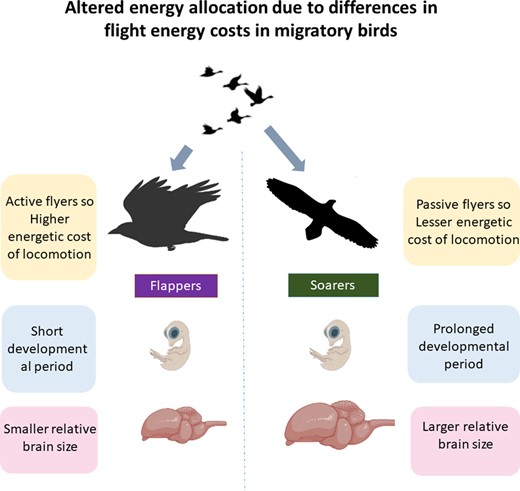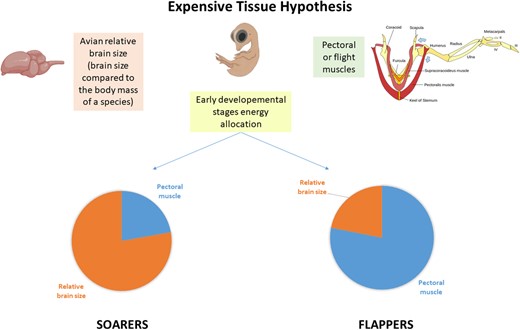-
PDF
- Split View
-
Views
-
Cite
Cite
Swati Saxena, David J. Hosken, Tusheema Dutta, Digest: Brain or brawn: Trade-offs between brain size and flight mode in birds, Evolution, Volume 76, Issue 8, 1 August 2022, Pages 1916–1918, https://doi.org/10.1111/evo.14548
Close - Share Icon Share
Abstract
Brain size is extremely variable across species, and its evolution depends upon the calorific trade-offs between it and other organs and activities. Shiomi investigated potential brain size trade-offs with different flight modes in birds. Flight can be energetically expensive, and costs are especially high with powered flight. This comparative study indicated that migratory birds employing less energetic modes of flight had relatively larger brains than migratory birds using powered flight, suggesting that brain size is impacted by the energetic costs of flight.
Brain size varies enormously across taxa (Köhler and Moyà-Solà 2004; Lefebvre et al. 2004), and understanding brain size evolution has generated much at times strong debate (Harvey and Pagel 1991). It has been suggested that much of the variation in brain size may be due to the energetic costs associated with developing and operating a large brain. That is, there are energetic constraints on brain size evolution; for example, as is evident in the apparent trade-off between brain and testis size across bats (Pitnick et al. 2006). An inverse correlation is seen between avian brains and pectoral muscle size (Isler and van Schaik 2006a), supporting the theory of energetic balance between the central nervous system and other systems (Fig. 1). Additionally, migratory birds tend to have smaller brains than resident species (Winkler et al. 2004; Sol et al. 2005, 2010), and brain size also increases as migration distance decreases (Sayol et al. 2016; Vincze 2016).

Altered energy allocation due to differences in flight energy costs.
In this article, Shiomi (2022) investigated brain size (measured as whole brain weight) across birds, with the primary focus on a possible trade-off between brain size and flight mode, given the putative cost of larger brains and the energetic costliness of flight, which varies with the mode of flight. In a vast, taxon-wide investigation, Shiomi (2022) collated data on brain size, flight mode (expensive powered-flapping flight vs. less energetically costly soaring flight), and migratory behavior (migrants vs. residents) across more than 2200 species. Controlling for body mass and phylogeny, findings suggested that migratory birds that employ soaring flight, using kinetic energy from the moving atmosphere, and thereby reducing flight costs, have larger brains than migratory birds that use powered flight. There were also contrasts in the results for nonmigratory versus migratory birds. Brain size variation was greater in nonmigratory birds, and among these, more species using powered (flapping) flight had larger brains than did soarers, a pattern that contrasted with that seen in migrants. Interestingly, although basal metabolic rate is correlated with brain size across mammals, this is not found across birds (Isler and van Schaik 2006a,b). Shiomi (2022) also found no association between basal metabolic rate and flight mode across birds.
How can these findings be interpreted? The data from migratory species are consistent with an energetic trade-off between brain size and flight mode. Migratory birds tend to have smaller brains than resident species (Winkler et al. 2004; Sol et al. 2005, 2010). Brain size increases as the migratory distance decreases (Sayol et al. 2016; Vincze 2016). So, it can be inferred that there is the trade-off between the brain size and flight mode in the migratory species. Shiomi found that among the migratory species, soarers have a higher relative brain size than flappers. The total developmental period of soarers was also higher than that of flappers for both migratory and nonmigratory birds (Fig. 2). This association may also be related to the costs of investing in the pectoral muscle needed for powered flight, as this muscle can comprise up to 18% of the body mass (Iwaniuk et al. 2004). Furthermore, trade-offs between muscle mass and brain mass may have contributed to the evolution of relatively large primate brains (Leonard et al. 2003). Why is brain size different in the residents versus migrants that use flapping flight? It is not clear, but perhaps there are other factors such as group size, foraging behavior, invasion success, and complex problem-solving ability that may play a role (Shultz and Dunbar 2006).

The expensive tissue hypothesis, which posits that soarers and flappers have different energy allocations from early developmental stages.
REFERENCES
——— (
Associate Editor: K. Moore
Handling Editor: T. Chapman
Submit A Digest
Digests are short (∼500 word), news articles about selected original research included in the journal, written by students or postdocs. These digests are published online and linked to their corresponding original research articles. For instructions on Digests preparation and submission, please visit the following link: https://sites.duke.edu/evodigests/.
Author notes
*This article corresponds to Shiomi, K. 2022. Possible link between brain size and flight mode in birds: does soaring ease the energetic cost of the brain? Evolution 76:649–657. https://doi.org/10.1111/evo.14425.



